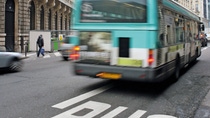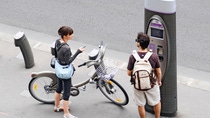Keeping the world moving
Making transport work better for all is a global priority. Which ideas are emerging and what concrete ideas already exist? Mary Crass of the International Transport Forum (ITF) discusses multi-modal systems, solutions for rural public transport, and designing towns for walkability.
Creating Chemistry: The ITF 2015 Summit took as its theme the three Ts – Transport, Trade and Tourism. What are your key areas of focus this year?
Mary Crass: Governments and actors throughout the transport sector must start treating the three Ts as interlinked sectors. Too often tourism is seen as something separate from trade, but it accounts for 21% of exported services and therefore plays a major role in trade. Transport enables both trade and tourism and is being challenged by growing demands in each of these areas. Annual global tourist arrivals are expected to reach 1.8 billion by 2030! We need more accessible tourist infrastructure and information for all visitors – notably the growing numbers of older travelers. On trade, governments must work together to cut documentary and procedural barriers as well as physical barriers. Overall, we need better policy coordination of all three Ts to deliver global economic development and social cohesion.

The ITF headquarters are in Paris, where air pollution was recently so bad that half the cars were banned from the roads and public transport made free for a day. Do you see your travelling conditions improving?
Overall, Paris has made huge strides in discouraging car use, without introducing congestion charging on the lines of London’s very powerful model. Dedicated bus lanes, for example, have cut the amount of road space available. Car and bike sharing is spreading. Challenges remain in outer areas, but the Grand Paris scheme is being presented as a model for other cities with plans for new automatic metro lines, stations and ring routes, and improved train service. Political commitment will be key in its realization.
A recent study sees fleets of self-driving shared cars replacing 90% of conventional cars in mid-sized cities. Given people’s attachment to the convenience of their own cars, is this realistic?
The car’s convenience lies in the predictability with which people feel they can get where they want, door-to-door. But congestion affects predictability, while car ownership has its costs, including those associated with vehicle purchase and maintenance, fuel and parking, and time spent finding parking. Mobility alternatives need to tackle the challenge of being on demand and covering the last journey kilometer, by offering connected travel across modes.
Larger cities need different solutions. If they can extend their public transport to offer some of the qualities of private car travel, for example by bringing in car and ride sharing as well as bike-sharing, that’s all to the good. People want comfort, accessibility and reliability; with these offered by other mobility solutions they stand a better chance of leaving their cars behind.
“Transport enables both trade and tourism and is being challenged by growing demands in each of these areas.”
Mary Crass, Head of Policy and Summit Preparation at the International Transport Forum

Your recent study of rural transport highlights the importance of better coordinated services. What do you see as the key issues for ensuring mobility for people who don’t live in towns?
Rural public transport costs more than public transport in dense urban areas. There is a role for government subsidies, but we also have evidence of rural dwellers’ willingness to pay more for services that are efficient even if they don’t offer the frequency available in towns. One example is demand responsive buses, which could be an option in low-density or rural areas. It is important that such services don’t operate in isolation, but as parts of larger, connected multimodal networks. Smartphone-accessible travel information is a key enabler.
What role will networked travel information and transport infrastructure play?
A crucial one, not least in deploying automated vehicles that can operate safely. The support of the entire intelligent transport systems industry will be needed, including electronic travel information, traffic and public transport management, driver assistance and automated safety systems.
A recent example is the European eCall regulation that requires new cars to be equipped with eCall technology from April 2018. In the event of a serious accident, eCall automatically communicates relevant information such as the vehicle’s location to emergency rescue services.
“People want comfort, accessibility and reliability; with these offered by other mobility solutions they stand a better chance of leaving their cars behind.”
Mary Crass, Head of Policy and Summit Preparation at the International Transport Forum
Car ownership is soaring in developing economies, generating rising congestion. When we compare this with Western experience, what lessons can be learned?
As average income increases, more and more people want their own car. While not necessarily denying opportunities for private vehicle ownership, decision-makers need to distinguish between car ownership and use, and ease people away from over-dependence on cars through policies that shape and manage use and through careful early planning based on access to services and amenities instead of strictly promoting mobility. Bus and rail corridors need to be planned with transit-oriented development in mind. Policy-driven parking restriction and charging can be effective.
Where public transport infrastructure and services are not yet well developed, policies that promote car and ride sharing can be pursued. And walking and cycling can be promoted as an integral part of transport policy.

Encouraging such alternatives depends on vulnerable road users being attracted to the idea and feeling safe. What needs to be done?
In too many countries, non-motorized transport remains on the margins of policy making. It needs to be brought forward with positive ‘keep the car at bay’ strategies for traffic calming, urban 30 kilometers per hour maximum zones, and car free areas.
Walkability is emerging as a residential or business locational criterion in the United States. Do you see this spreading?
Yes, provided that local governments are prepared to flip the urban planning process on its back, considering access to amenities and services first as well as proximity to public transport. The idea is well accepted in North America, for example, in the form of transit-oriented development. This provides for new homes, shops and workplaces to be clustered within easy walking distance of transit stops and stations.
The environmental agenda sees electric vehicles playing increasingly important roles. How can public policy encourage e-mobility?
E-mobility is an important issue for governments. They can encourage it by giving grants and purchase subsidies, legislating for electric vehicle uptake in public sector fleets, and supporting research and development in new battery and charging technologies. But although electric cars have environmental benefits, they also face hurdles. ITF research shows that their cost is still often higher than equivalent internal combustion vehicles. The gap may narrow with higher volumes of production, but internal combustion vehicles may still provide higher range at lower cost in many scenarios. Also, when evaluating their environmental benefit, it's necessary to consider the carbon-intensity of the electricity production. Generally, future mobility solutions will be powered by different sources of energy – electricity, certainly, but also hydrogen, solar, and biofuels. Until new technologies reach scale, improvements in fuel efficiency of existing engine technologies will be essential.
What are the next big issues you’re addressing in the run up to your 2016 Summit?
Next year’s theme is ‘Green and Inclusive Transport’. Transport is a major enabler of economic growth and development: Cheaper, safer, more reliable and frequent transport facilitates trade and the movement of people and enables people to access employment, goods and services. The transport model that facilitates this economic exchange is, however, not currently environmentally sustainable. Our research shows that, globally, transport remains 97% dependent on fossil fuels, and contributes up to 25% of CO2 emissions. Without action, its output will rise by 170% by 2050. We believe green transport can be a driver of green economic growth. But some segments of society are impeded from accessing opportunities as a result of their income level, mobility, location, or prohibitive transport costs. Inclusive transport implies that everyone has access to the labor market, education and public amenities, as well as social and leisure activities.

